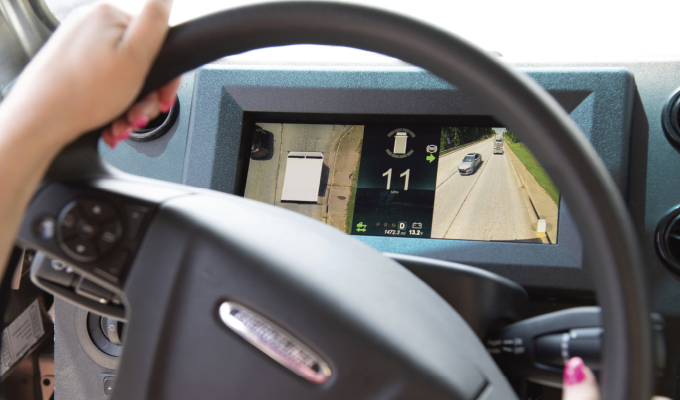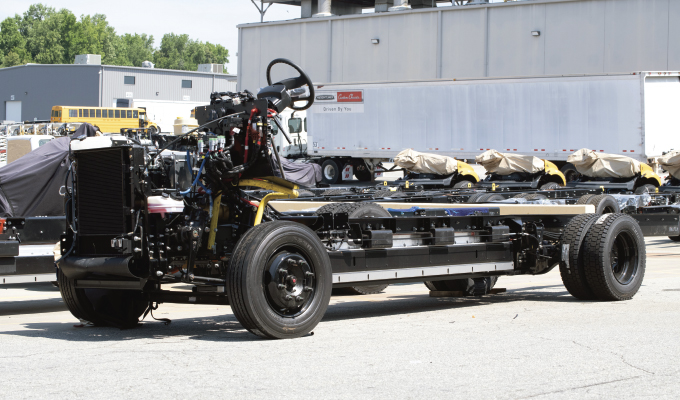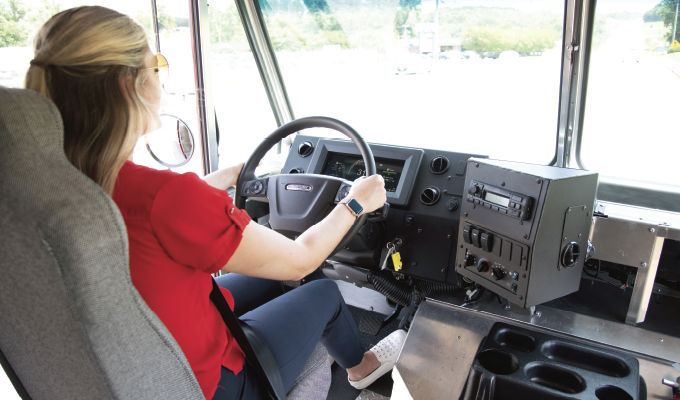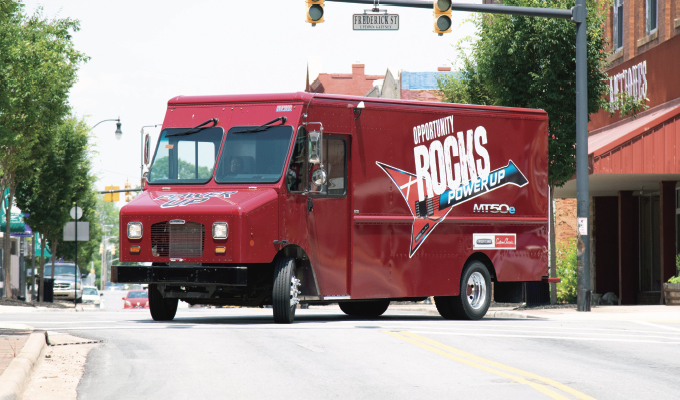It seems there’s no shortage of electric work vehicles in the media and on the industry radar. But of those vehicles, few are in use by fleets today. Will those concepts ever be in production? That isn’t the case with the MT50e, the electric walk-in van from Freightliner Custom Chassis Corporation (FCCC). The vehicle is the result of a three-way partnership that marries proven components with a revolutionary concept that will aid delivery fleets in their zero-emissions goals.
PARTNERSHIP POWER
Teamwork makes the dream work, and the MT50e is a prime example of the result of a shared mission. A partnership between FCCC, Daimler Trucks NA, and Proterra made the MT50e possible. This all-new and all-electric walk-in van offers a range of 150 to 170 miles, features a performance of 70 mph at a GVWR of 23,000 lbs, and it comes with an eight-year/175,000-mile warranty—and that’s all while giving off zero emissions.
As for the battery itself, FCCC chose its partner wisely.When developing the MT50e, the partnership with Proterra allowed FCCC to keep its focus on the chassis. Mike Stark, product manager at FCCC, says that while designing the MT50e, FCCC didn’t have to worry about the durability or reliability of the Proterra battery because “it was already proven.” And he’s right. The Proterra battery packs already have more than 20 million proven miles under their belt with transit buses. The battery packs designed for the MT50e feature 226 kWh, or the equivalent of 303 hp. And the best part, these batteries charge in just three hours.
Those with range concerns can rest easy. That’s because the MT50e also uses regenerative braking, which captures energy from braking and converts it into battery energy for an increased range. From a safety perspective when driving on snowy or slick roads, the regen feature can be turned off, which will illuminate an icon in the instrumentation alerting the driver of the Regen status.
Further, FCCC built the body of the MT50e to the same specifications as the gas- and diesel-powered MT products. This means owners can integrate the MT50e into their existing fleet, using the electric vehicle in the same application and using the same upfits that are already known and loved by operators. Finally, FCCC built the MT50e’s chassis with single-piece steel frame rails and Detroit front axles that deliver a 50-degree wheel cut.

COMFORT & TECH
Would it be a true EV without the latest technology integration? FCCC thinks not. Aiding drivers in operation as well as safety, the MT50e features an OptiView instrument cluster. The OptiView is essentially the brains of the MT50e’s safety system. This fully integrated, digital LCD cluster provides drivers with vehicle information at a glance with a clean, streamlined look that won’t distract drivers. FCCC intended this technology to replicate that of what drivers experience in their personal vehicles.
Other features that drivers will find similar to their personal vehicles include a left-handed stalk, automatic headlights, 360-degree camera system and sensors (complete with an overhead sensor for vehicle height), turn signal cameras, traction, and stability control. Further, the MT50e’s rotary dial shifter allows fingertip operation. This makes it easy for drivers to shift gears without taking their eyes off the road.

MAINTENANCE
The word in the industry is that electric vehicles require less maintenance overall, but that doesn’t mean EVs are completely maintenance free. In fact, there are a few maintenance checkpoints the MT50e should undergo on a periodic basis to keep it running for years to come. Those checkpoints include: cooling system changes every three to five years and brake, tire, and Freon checks. One maintenance aspect that might take some getting used to is the fact that the MT50e uses no filters, which significantly changes routine maintenance.
For issues that do arise, FCCC has been training its dealers’ service technicians for the past two years on electric vehicle maintenance. Rest assured, if your MT50e needs a little bit of TLC, your dealer should have trained technicians at the ready. FCCC will also provide service training for large fleets. And for an added cushion of assurance, FCCC can also send a technician to your location to assess issues.
If there’s ever a problem with the MT50e Proterra battery, you’ll likely know about it through an alert before your drivers notice a change in performance. This is because the battery pack sends a fault code in the event of even a single failed battery cell.
During my visit with the folks at FCCC, we also discussed brake maintenance. Using regenerative braking is a great way to increase the range on your EVs or hybrid vehicle, but these non-conventional brakes could mean different maintenance. FCCC designed the MT50e’s four-piston brakes to last up to 100,000 miles—which FCCC has already proven. In fact, I’m told the MT50e’s brakes could even last the life of the vehicle.
FCCC is also developing a service app, 24/7 Direct, that can aid owners and drivers on scheduling maintenance and send reminders when maintenance is due.

THE DRIVE
With the MT50e being the first electric vehicle for me to drive, I wasn’t sure exactly what to expect. But aside from the vehicle’s exterior “MT50e” decals, it didn’t take long for me to notice the difference between a gas- or diesel-powered walk-in van and the new MT50e. In fact, I noticed the difference after simply “cranking” the electric motor. The vehicle was so quiet, I could hear birds chirping and the breeze blowing the leaves of the trees.
The next thing I noticed was the vehicle’s instant torque. Imagine the torque you feel when driving an electric golf cart. That’s the best comparison I can make with the MT50e’s torque. If your mind went directly to the moments you’ve floored it in the golf cart and the momentum pushed you backward, don’t be alarmed. The MT50e’s power feels controlled and continuous while increasing the vehicle’s speed. While driving the MT50e, you won’t feel the transmission shift gears; it’s more like a steady flowing boost of power that increases as you accelerate.
Even with the significantly quieter operation and the electric powertrain, the MT50e drove like, well, a vehicle. In my opinion, drivers should experience a smooth transition from a conventional walk-in van to the MT50e.
In fact, I’m not the only one to test-drive the MT50e. Currently, there are several MT50e units in fleet service performing customer revenue operations that have demonstrated the reliability and durability of the truck.
FUTURE FORWARD
With the latest technology integrations, proven Proterra battery technology, and the brawn of FCCC and Daimler Trucks, the MT50e is well on its way to making major waves in the industry. FCCC is in the process of releasing several new features for the MT50e model including smaller batteries for customers that require less range, additional wheelbases, and exportable power for applications such as utility operations.
ABOUT THE AUTHOR
Jade Brasher is the editor of Modern WorkTruck Solutions magazine. Reach her at jade@mwsmag.com. Find out more about the FCCC MT50e, visit www.electricwalkinvan.com.




